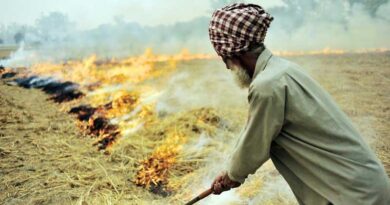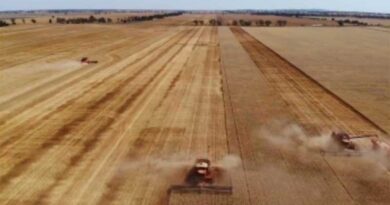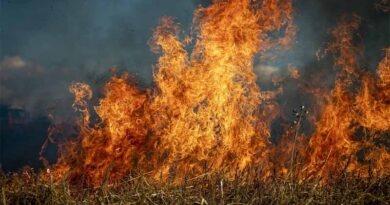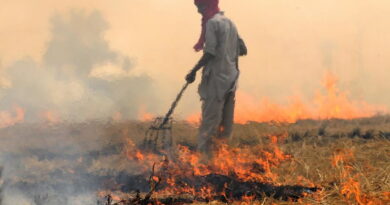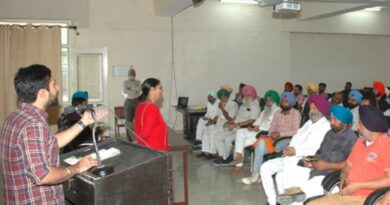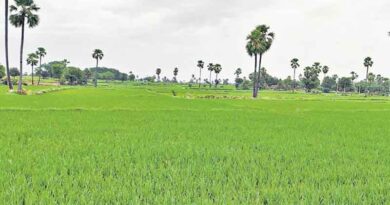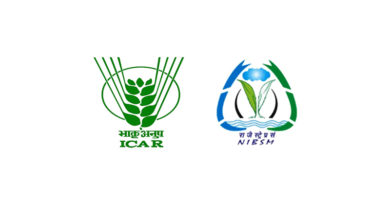Haryana prepared to manage crop residue burning issue
- Union Minister chairs high-level meeting with States, ahead of the approaching winter season when incidences of stubble burning tend to increase leading to dangerous rise in the levels of air pollution
- Center lauds steps taken by Haryana for improving air quality, decreasing pollution levels and stubble management
- Haryana Chief Minister shares State’s action plan for improvement of air quality in NCR
- Formaldehyde Industries should be re-opened, urges Chief Minister
- The total area under paddy in Haryana has been reduced upto 10.7 percent, compared to last year, Manohar Lal
- Villages categorized into Red, Yellow and Green zones in terms of incidences of crop residue burning, Manohar Lal
24 September 2021, Chandigarh: Haryana is fully geared up to handle the issue of agricultural crop residue burning and air pollution issues ahead of the winter season in the State.
This was stated by Haryana Chief Minister, Mr. Manohar Lal while speaking during a high-level meeting chaired by Union Minister of Environment, Forest and Climate Change, Mr. Bhupender Yadav to discuss the implementation of an action plan for improvement of air quality in NCR ahead of the approaching winter season, when the incidences of stubble burning tend to increase leading to dangerous rise in levels of air pollution.
The meeting which was held through video conferencing was attended by Ministers and higher officials of various departments from Delhi, Punjab, Rajasthan and Uttar Pradesh.
Also Read: FICCI’s conducts 10th Agrochemical Conference 2021on Sustainable Growth of Agrochemical Industry
Lauding the dedicated steps taken by Haryana for improving air quality, Mr. Bhupender Yadav said that the Haryana Government’s decision to use bio-decomposer technology on one lakh acres of area is certainly a pivotal step for stubble burning management. He also appreciated the work done by State Government for switching industries to CNG and PNG.
“Haryana Government has done remarkable work in the field of stubble management as a result of which decline has been seen in the number of stubble burning incidences in the State,” said Mr. Bhupender Yadav.
Formaldehyde Industries should be re-opened
The Chief Minister urged the Centre Government for the re-opening of Formaldehyde Industries in Yamunanagar. Urging the Union Minister, Mr. Bhupender Yadav, Mr. Manohar Lal said that due to some objection these industries were closed but then later the registration for their refunctioning was started but then again these units were closed due to court orders.
“I urge Centre government to intervene in this matter so as to give some relief to the industrialists running these units,” said Manohar Lal.
Work of laying CNG-PNG pipelines should be expedited
The Chief Minister while urging the Union Minister, Mr. Bhupender Yadav to expedite the work of laying CNG and PNG pipelines in the pending areas of the State said that because of the non-availability of these pipelines many industries might shut down. On the places where the pipelines are available switching the industrial units to CNG and PNG has already been done in a phased manner, informed Mr. Manohar Lal.
The Chief Minister also urged the Union Minister to allow the implementation of pollution control provisions as district specified rather than entire NCR specified as sometimes difficulty is being faced while implementing these provisions.
“At present around 47 percent area of Haryana comes under NCR region. Therefore it is urged that all such provisions should be implemented within the radius of 10 km of NCT and Delhi or within the 10 km radius of cities having10 lakh population or these provisions should be implemented as per district specified, not as NCR,” said Mr. Manohar Lal.
The total area under paddy in Haryana has been reduced upto 10.7 percent, compared to last year
Mr. Manohar Lal informed that the total area under paddy in Haryana is 34.10 lakh acres (57 percent Basmati and 43 percent Non-Basmati). The area has been reduced upto 10.7 percent in comparison to the previous year with the efforts of the State.
As many as 34,372 machines (besides 19,353 Rotavators which are removed from the list of Crop Residue Management (CRM) implements by the Government of India are available in Haryana with individual farmers in 4,224 Custom Hiring Centers.
Villages categorized into Red, Yellow and Green zones in terms of incidences of crop residue burning
In a bid to ensure efficient management of stubble burning, the villages of the State have been categorized into Red, Yellow and Green Zones in terms of incidences of crop residue burning based on the data provided by the Haryana Space Applications Centre (HARSAC) to the Agriculture and Farmers’ Welfare Department.
A detailed action plan has been prepared for the prevention of crop residue burning in the current season and the same has been discussed at length with the Commission for Air Quality Management in NCR and Adjoining Areas (CAQM).
It was further informed that Haryana is providing assistance on Crop Residue Management (CRM) machines that is 50 percent for individuals and 80 percent for Custom Hiring Centers. An amount of Rs. 198.53 crore is available under the scheme. Further, the funds released under Sub Mission on Agricultural Mechanization (SMAM) scheme will also be utilized for providing CRM machinery.
It was informed that applications invited in the first phase have been processed by Deputy Commissioners concerned, and all the applicants in Red and Yellow zone village have been allowed to purchase the machines.
In the second phase applications from Red and Yellow zone villages have been invited till September 25, 2021, and the same will be processed on September 28, 2021, by Deputy Commissioners who are the Chairmen of the Committee constituted for the purpose. Besides this, an App called FARM has been developed for the booking of equipment by farmers.
The Nodal officers are being deployed at district, sub-division, block, village level and mapping of the available panchayat common land is being made for storage of baled residue for ex-situ use.
Initiatives for crop management
As a unique initiative of its own kind, Haryana is implementing a State scheme for providing an incentive rate of Rs. 1000 per acre on paddy straw by product for the management of crop residue for baled paddy. A provision of rate of Rs. 200 crore has been made during the current year.
A control room has been established at the Directorate of Agriculture and Farmers’ Welfare for monitoring of actions taken to curb the crop residue burning in the State on a day to day basis. Similar control rooms have also been established at the District level for monitoring and preventing fire incidents.
Haryana has also launched a flagship scheme namely ‘Mera Pani Meri Virasat’ (MPMV) for diversification of paddy area to other alternative crops under which a provision of giving incentive of Rs. 7000 per acre is being given to the farmers for adopting crop diversification.
Monitoring of Active Fire Locations (AFLs) has already been started from September 15, 2021, by Haryana State Pollution Control Board through HARSAC, following the standard protocol approved by the CAQM. Till date, not even a single incident of farm fire has been identified in Haryana.
Bio Mass Power Projects started for paddy straw management
The State has set up Bio Mass Power Projects to the tune of 64.3 MW consuming 2.37 lakh MT of paddy straw and another 2.41 lakh MT of paddy straw is being used by other industries.
Another six Bio Mass Power Projects of 60.35 MW production capacity, with a capacity to utilize 6.4 lakh MT of paddy straw and one Compressed Bio Gas Plant of 12.5 Tonnes per Day capacity which can use 40,000 MT of paddy straw are under installation.
Further a project on Ethanol Production has also been under installation, with a production capacity of 100 KLPD and a utilization capacity of 2 Lakh MT of paddy straw.
The State is initiating many IEC activities and programmes through Agriculture Department, to prevent crop residue burning.
The matter is being reviewed regularly at the level of the Chief Secretary and Additional Chief Secretary Agriculture and Farmers’ Welfare Department.
“With all these efforts, we are hopeful that we will be able to prevent the crop residue burning in this season. Besides the crop residue burning issue, the State is also preparing itself to handle the air pollution issues arising during every winter season,” said Mr. Manohar Lal.
The Haryana State Pollution Control Board (HSPCB) has constituted special teams to check the industrial areas to prevent the illegal use of unapproved fuel in factories and is conducting regular drives in the NCR districts of Haryana.
Conversion of Brick Kilns to Zig-Zag Technology
The Chief Minister said that of 3228 Brick kilns in the State of Haryana, 2137 are located in NCR and 1762 have been converted to Zig-Zag Technology. No brick kiln is allowed to operate if they are not converted. 1091 brick kiln units located in Non-NCR have also been converted to zig-zag technology. Besides this in a bid to provide clean fuel several industries in NCR have been converted to PNG in NCR Districts of Haryana, he added.
The Chief Minister informed that State Pollution Control Board has banned the establishment of new Pyrolysis units and existing units are subjected to stricter SOP norms.
Haryana State Pollution Control Board has established a control room in Gurugram for the redressal of air Pollution related complaints 24X7 during the GRAP period, he added.
Additional Chief Secretary, Environment and Climate Change Department, Mr. S.N Roy, Principal Secretary to Chief Minister, Mr. V. Umashankar, Deputy Principal Secretary to Chief Minister, Smt. Ashima Brar, Director General, Agriculture, Mr. Hardeep Singh and Member Secretary, Haryana State Pollution Control Board, Mr. S. Narayana also remained present on this occasion.



